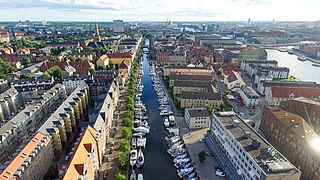
Christianshavns Kanal is a canal in the Christianshavn neighbourhood of Copenhagen, Denmark. Running northeast–southwest, it bisects the neighbourhood along its length. To the north it connects to Trangraven, the canal which separates Christianshavn from Holmen; to the south it makes an angular break and empties in the main harbour a little north of the Langebro bridge. At the middle, Christianshavns Kanal is crossed by Børnehusbroen. This bridge is part of Torvegade, the main thoroughfare of Christianshavn, connecting the city centre across Knippelsbro to the northwest to Amager the southeast. The only other bridge traversing the canal is Snorrebroen, located further north.

Steinfass House is a listed house overlooking Christianshavn Canal in the Christianshavn neighbourhood of Copenhagen, Denmark. It is now part of the Sofiegården hall of residence.

Sankt Annæ Gade is a street in the Christianshavn district of Copenhagen, Denmark. It connects the main harbourfront at Asiatisk Plads in the west to Christianshavn Rampart in the east via the Snorrebroen bridge. Church of Our Saviour is located in the street.

Wildersgade Barracks was a barracks which existed from 1802 until 1822 in the Christianshavn district of Copenhagen, Denmark. Its former premises, which include a purpose-built main building on Wildersgade and converted warehouses, two of them facing Christianshavn Canal, are now listed. They surround a central courtyard which has been converted into a community garden.

Andreas Bjørn was a Danish merchant, shipbuilder and ship owner.
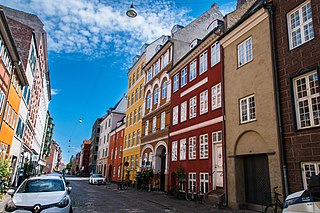
Wildersgade is a street in the Christianshavn district of Copenhagen, Denmark. It runs along the length of the neighbourhood, parallel to Christianshavn Canal, one block to the east, from the Christiansbro development in the south(west) to Wilder's Canal in the north(east). The street is bisected by Torvegade, Christianshavn's principal thoroughfare, but is otherwise a quiet mainly residential street with cobbling and many old townhouses and storages from the 18th and 19th century.

The Seamen's Association of 1856 was founded in Copenhagen in 1856. It runs Princess Marie's Home for Old Seamen and Seamen's Widows in Christianshavn where the association is also based.

(Kongelige) Grønlandske Handels Plads is a waterfront area at the end of Strandgade in the northwestern corner of the Christianshavn neighbourhood of Copenhagen, Denmark. The area is bounded by the Trangraven canal to the north, Christianshavn Canal to the east, Krøyers Plads to the south and the main harbor to the west. The waterfront is also known as Nordatlantens Brygge. It is named for the Royal Greenland Trading Department and was for more than 200 years a hub for Danish trade on Greenland, Iceland and the Faroe Islands. The most notable building is North Atlantic House, an 18th-century warehouse now used as a cultural centre for the North Atlantic area.

The Niels Brock House is a historic property located at Strandgade 36 in the Christianshavn neighbourhood of Copenhagen, Denmark. The property comprises the former warehouse at Wildersgade 51 on the other side of the block as well as a number of side wings in the yard. The building takes its name after the businessman Niels Brock for whom it was adapted in the 1780s. Other notable former residents include the historian Peter Vilhelm Jacobsen (1799–1848) and the businessman Christian August Broberg. The entire complex was listed in the Danish registry of protected buildings and places in 1918.
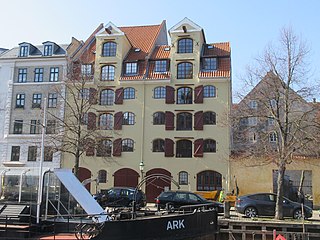
The Snorrebroens Pakhus, located at Overgaden Neden Vandet 45–47, is a former warehouse overlooking Christianshavn Canal in the Christianshavn neighbourhood of Copenhagen, Denmark. It consists of what was originally two individual but almost identical warehouses from circa 1800 which were merged into one building in the 1860s and has now been converted into apartments. The name, which is of modern origins, refers to Snorrebroen, the bridge that carries nearby Sankt Annæ Gade across the canal.
Johan Bernhardt Schottmann was a German-Danish master builder who worked in Copenhagen, where he was an early proponent of the Neoclassical style. The Schottmann House at Strandgade 10 in Christianshavn is named after him.

The Andreas Bjørn House is a historic property located at the corner of Strandgade and Bådsmandsstræde in the Christianshavn neighbourhood of Copenhagen, Denmark. It was built for Andreas Bjørn in 1734 and listed on the Danish registry of protected buildings and places in 1918. A sugar refinery named Union House was from 1771 to 1811 located in a now demolished warehouse adjacent to the building by a group of British merchants and plantation owners from St. Croix in the Danish West Indies.

Peter Fenger was a Danish merchant and slave trader. He participated in the triangular trade.
Peter Borre was a Danish merchant and slave trader. He owned the Copenhagen-based trading house Borre & Fenger in a partnership with Peter Fenger from around 1755. The company traded in the Danish West Indies with its own fleet of merchant ships. Borre owned the Irgens House at Strandgade 44 in Copenhagen as well as several other properties in the city.
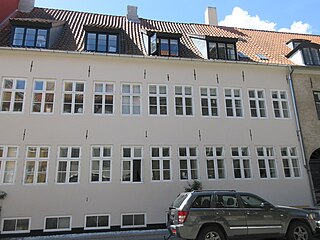
Sankt Annæ Gade 4 is a historic property on Sankt Annæ Gade in the Christianshavn neighborhood of Copenhagen, Denmark. Built as a warehouse in the 1620s, in 1757 it was converted into a two-storey residential building by anchor smith Hans Caspersen. The first of a number of construction projects undertaken by Caspersen in the neighborhood, he would later also build or significantly expand the buildings at Overgaden Neden Vandet 39, Overgaden Neden Vandet 33 and Overgaden Oven Vandet 50. The building was listed on the Danish registry of protected buildings and places in 1950.
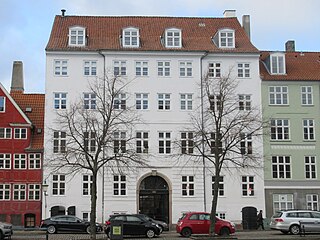
Overgaden Neden Vandet 39, is a historic property in the Christianshavn neighborhood of Copenhagen, Denmark. It is one of three properties along Christianshavn Canal that were built by anchor smith Hans Caspersen and are now all known as the Hans Caspersen House, the others being Overgaden Oven Vandet 50 and Overgaden Neden Vandet 33. The building at Sankt Annæ Gade 4 is also associated with Caspersen. The building was listed on the Danish registry of protected buildings and places in 1918.
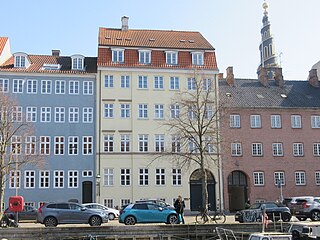
Overgaden Oven Vandet 50 is a residential property in the Christianshavn neighborhood of central Copenhagen, Denmark. It is one of three properties along Christianshavn Canal that were built by anchor smith Hans Caspersen and are now all known as the Hans Caspersen House, the others being Overgaden Neden Vandet 39 and Overgaden Neden Vandet 33. The building was completed in 1769 and listed on the Danish registry of protected buildings and places in 1945.

Overgaden oven Vandet 54–56 is a complex of Late Neoclassical buildings situated at the corner of Overgaden Oven Vandet and Bådsmandsstræde, adjacent to Søkvæsthuset, in the Christianshavn neighborhood of central Copenhagen, Denmark. The two buildings originate in a two-storey bourgeois townhouse from the first half of the 18th century but were both heightened to five storeys by silk hat manufacturer and developer H.P. Lorentzen in the 1840s. The two buildings were individually listed in the Danish registry of protected buildings and places in 1945.

The Sigvert Grubbe House is a Renaissance style townhouse situated at Strandgade 28 in the Chrstianshavn neighborhood of central Copenhagen, Denmark. The property comprises the building at Wildersgade 41 on the other side of the block as well as a half-timbered building separating two central courtyards from each other. The apartment on the first floor features a number of murals attributed to Nicolai Abildgaard. The entire complex was listed in the Danish registry of protected buildings and places in 1918. It takes its name after its first owner, Sigbert Grubbe, a favourite of ChristianIV. It was later owned by Jacob Benjamin Italiaender, a Sphardi Jew, who established a tobacco manufactory as well as a private sunagogue in the yard. The painter Peder Severin Krøyer grew up in the building in the 1860s.

O – Overgaden, or simply Overgaden, is a non-profit contemporary art venue situated at Overgaden Neden Vandet 17 in the Christianshavn neighbourhood of central Copenhagen, Denmark. It hosts approximately eight major exhibitions each year. Constructed in 1887 to designs by Frederik Bøttger, an architect who also worked for Arbejdernes Byggeforening, Overgaden Neden Vandet 17 was originally built for a charity as a public dining facility. In 1893, it was acquired by C. Ferslew & Co. and converted into a printing workshop under the name Centraltrykkeriet. In 1936, it was expanded with a large funkis-style extension on the rear. The art centre opened in 1986. The building was together with Wildersgade 20 on the other side of the block listed in the Danish registry of protected buildings and places in 1989. The extension from 1936 is not part of the heritage listing.























